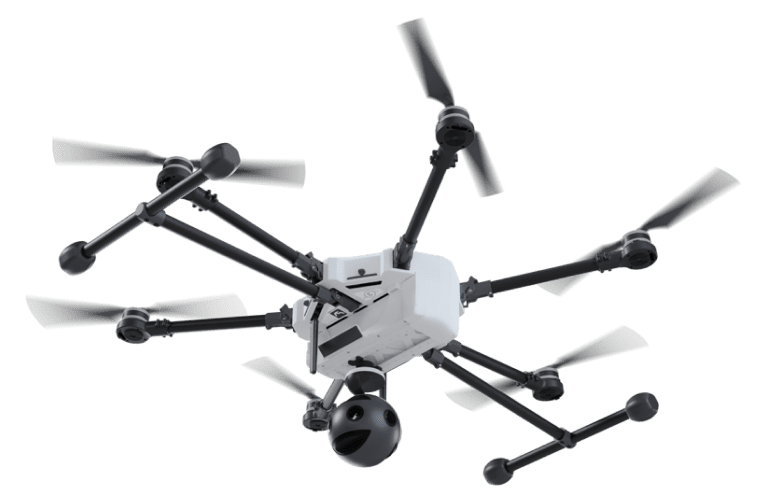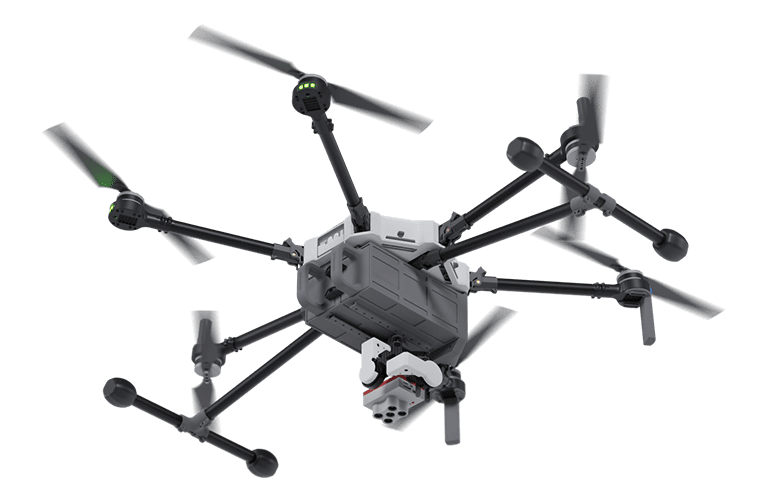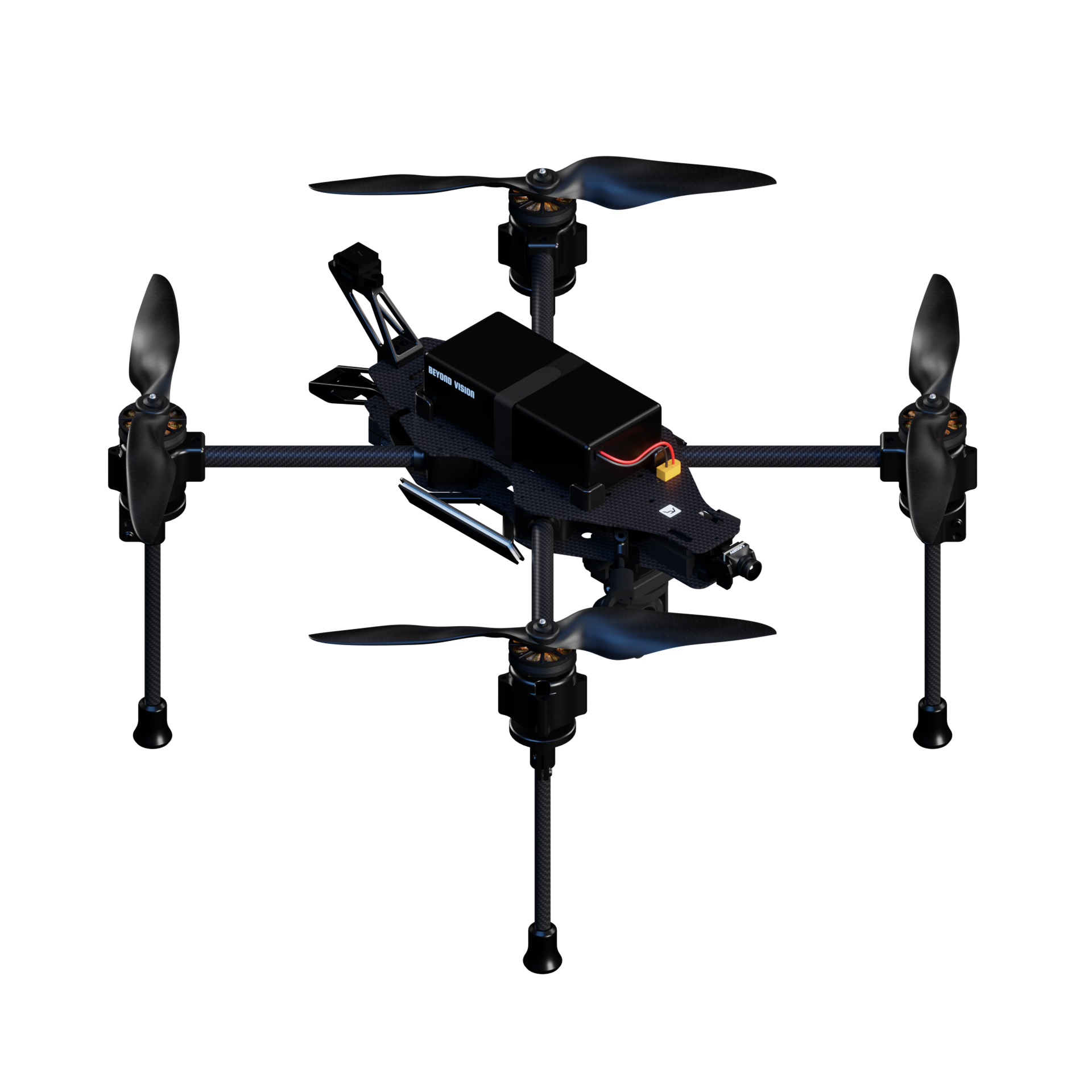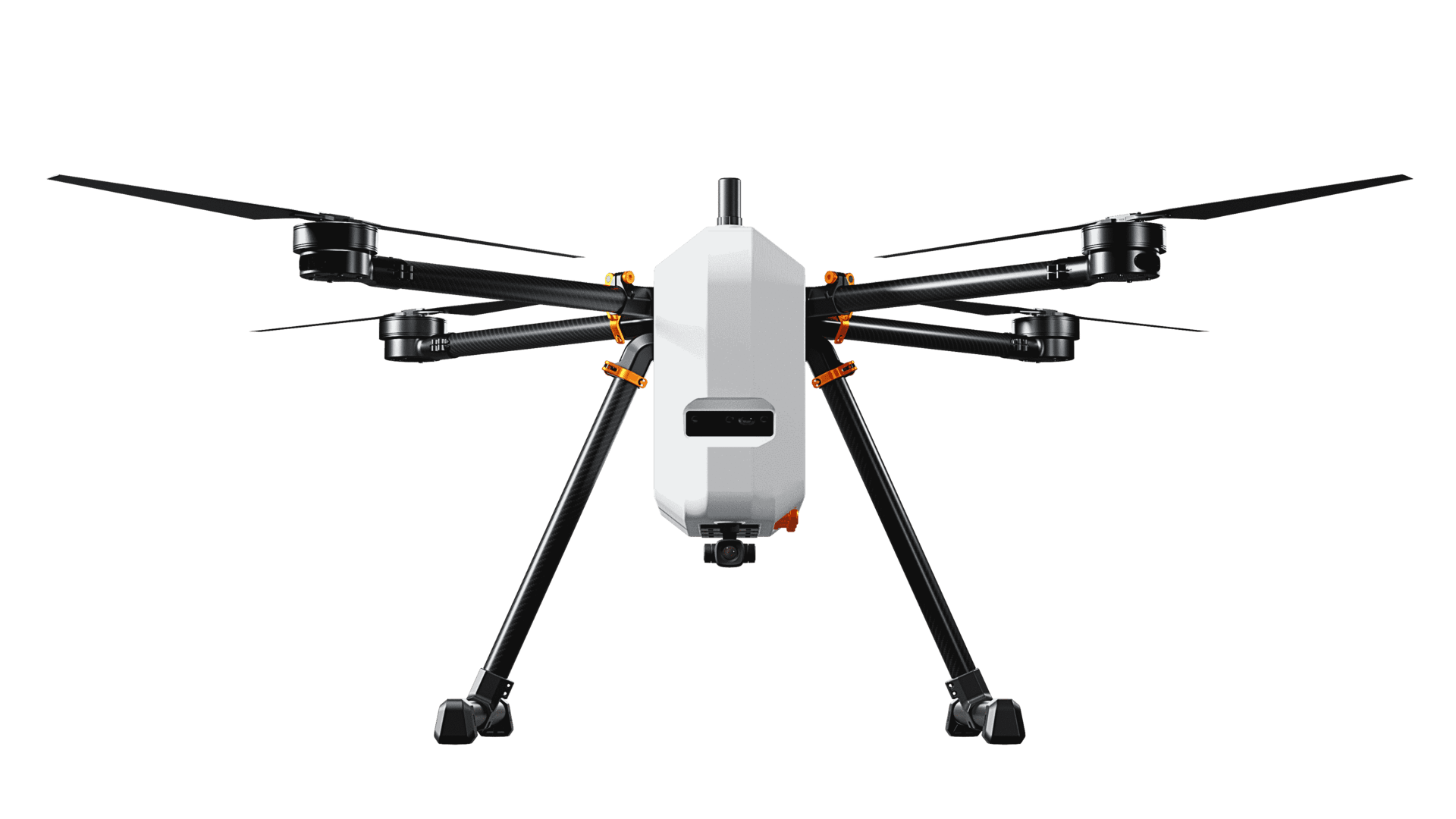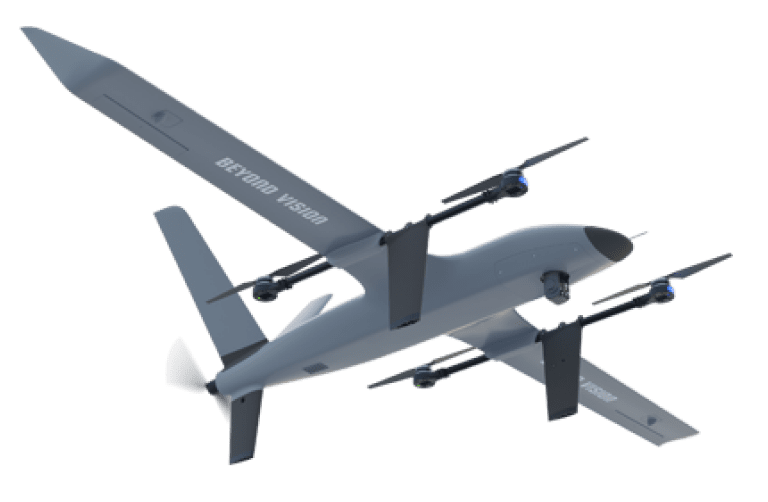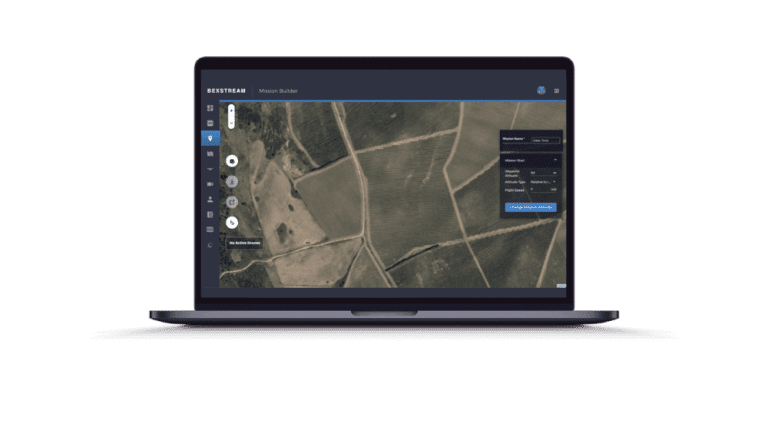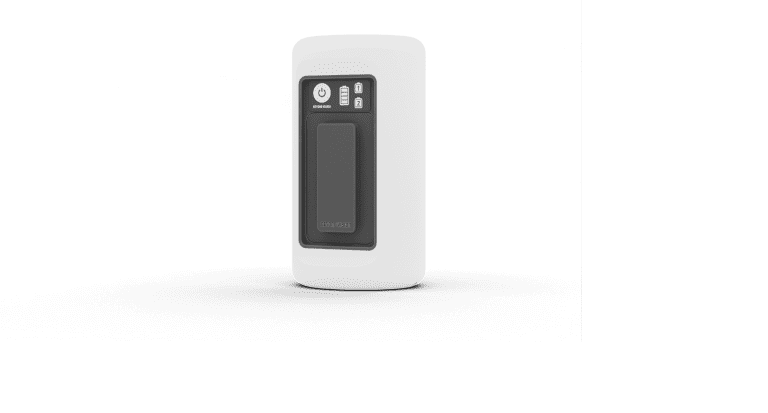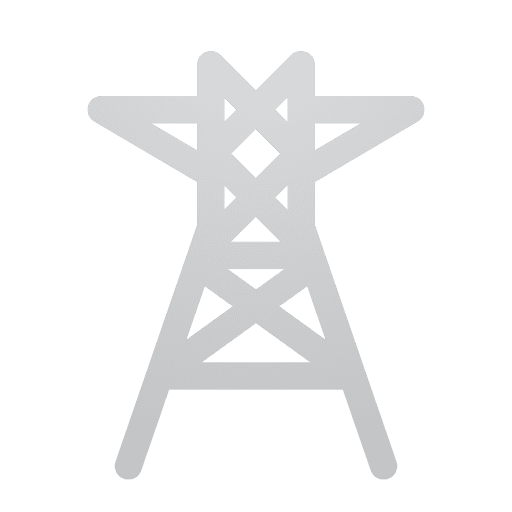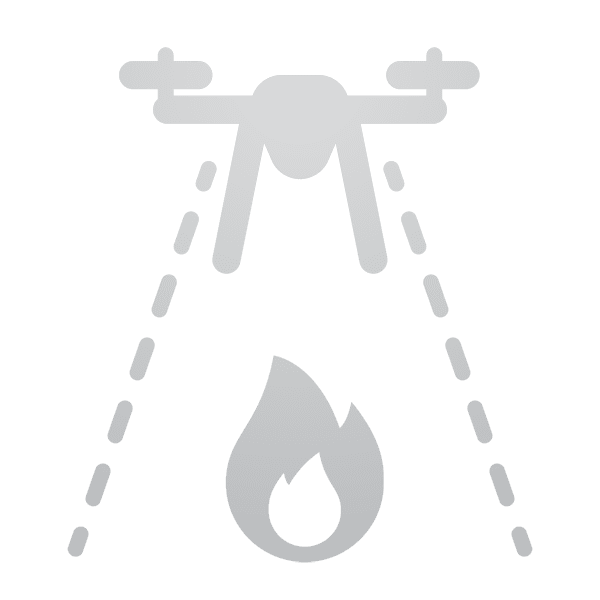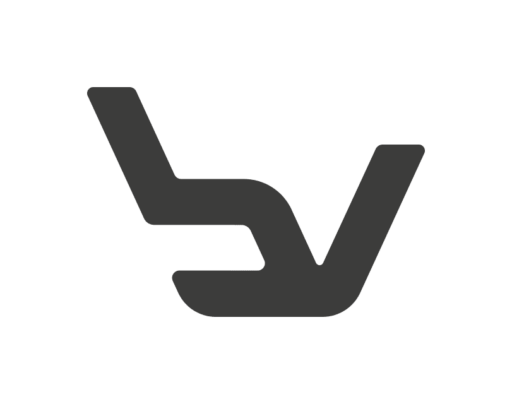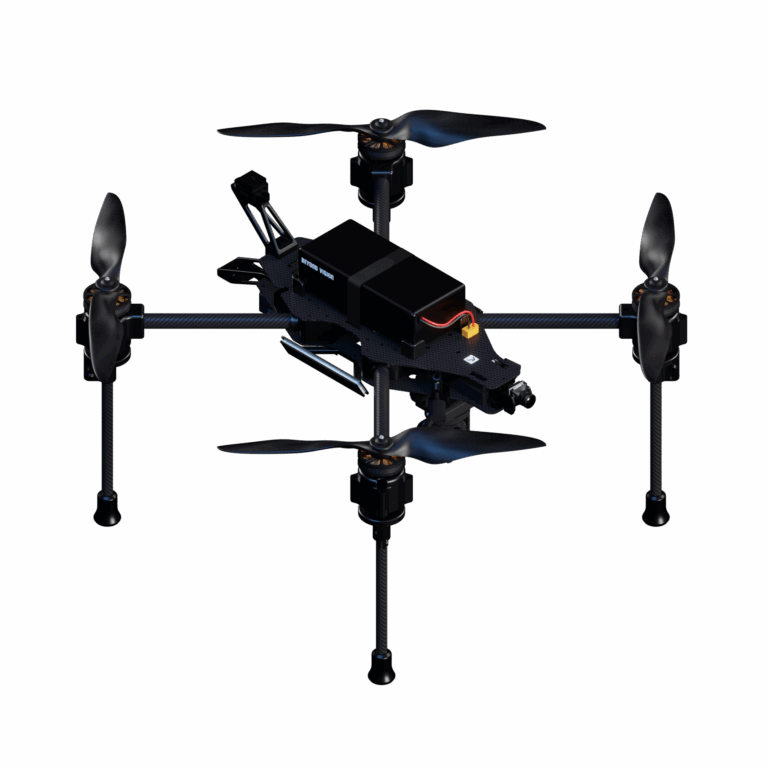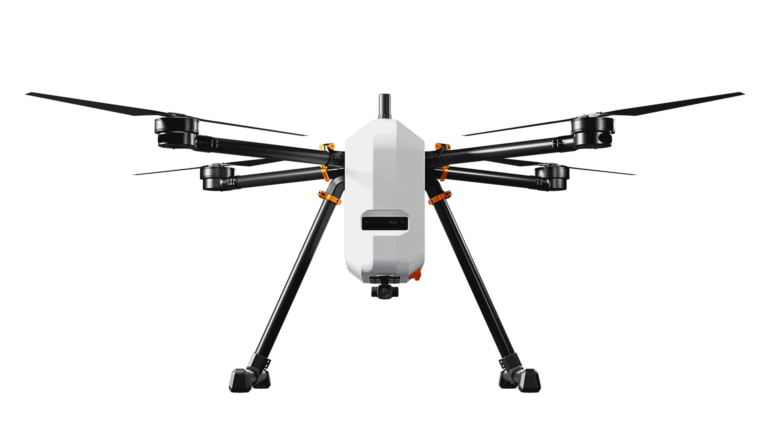Eine effiziente Landwirtschaft ist im Laufe der Jahre immer wichtiger geworden, da die Bevölkerung ständig wächst und damit auch der Bedarf an Nahrungsmitteln steigt.
Die autonome Landwirtschaft ist ein wesentlicher Faktor für die Vereinfachung und Beschleunigung der Landwirtschaft
Landwirtschaftliche Drohnen können helfen, den Boden zu analysieren und so die Pflanzengesundheit zu verbessern
Index
- Verbesserung der Landwirtschaft durch Autonomie: Die Zukunft der Landwirtschaft mit autonomen UAS erschließen
- Der Bedarf an autonomen UAS in der Landwirtschaft
- Die Rolle der europäischen UAS-Verordnungen in der Landwirtschaft
- Jenseits der Fernsteuerung: Der Aufstieg der vollautonomen UAS
- Wie werden Drohnen für landwirtschaftliche Zwecke eingesetzt?
- Systemanforderungen für unbemannte autonome Landwirtschaftsfahrzeuge (UAV)
- Herausforderungen und Chancen
- Schlussfolgerung: Ein Weg in die Zukunft für UAV in der Landwirtschaft
- 3 Minuten Zusammenfassung
- Ihre Fragen werden beantwortet
Verbesserung der Landwirtschaft durch Autonomie: Die Zukunft der Landwirtschaft mit autonomen UAS erschließen
Während die Weltbevölkerung weiter wächst, werden die Ressourcen immer knapper. Dementsprechend hat die steigende Nachfrage nach Lebensmitteln zu einem Anstieg des Bedarfs an Ressourcen wie Wasser, Dünger und Arbeitskräften geführt. Als Antwort auf dieses Problem hat sich die Agrarindustrie innovativen Lösungen wie der autonomen Landwirtschaft zugewandt, aber was genau ist das?
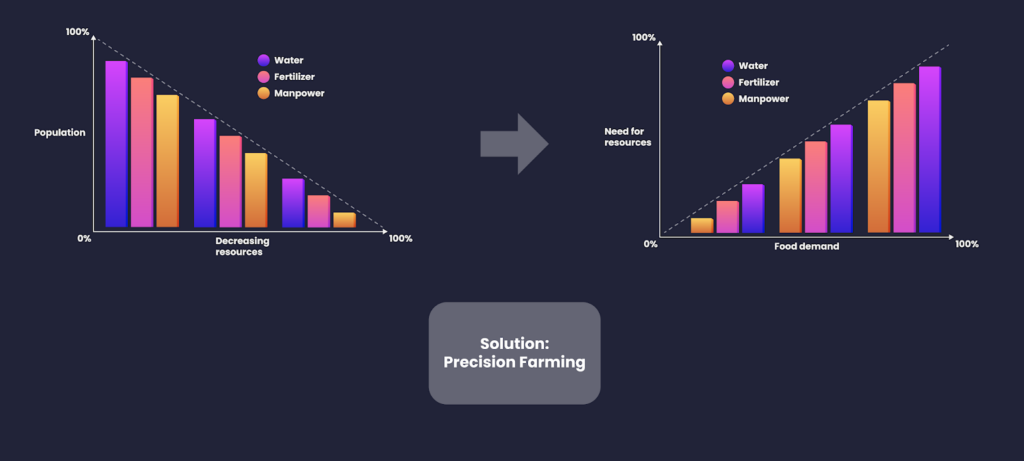
Die Folgen des Bevölkerungswachstums
In der Präzisionslandwirtschaft (auch als autonome Landwirtschaft oder Präzisionslandwirtschaft bezeichnet) werden Technologien eingesetzt, um die Erträge zu maximieren und gleichzeitig den Einsatz dieser Ressourcen zu minimieren und so Zeit und Kosten zu sparen. Eine dieser Technologien, die sogenannten unbemannten Luftfahrtsysteme (UAS), sind in diesem Prozess unverzichtbar geworden. Durch die häufige Erfassung hochwertiger Echtzeitdaten verbessern UAS die Überwachung landwirtschaftlicher Güter wie Pflanzen und Vieh.
Basierend auf den Ergebnissen des AFarCloud-Forschungsprojekts (Aggregated Farming in the Cloud) der Europäischen Union macht die autonome Landwirtschaft rasche Fortschritte. Das Projekt zeigt das Potenzial eines vollständig autonomen UAS-Betriebs auf und beschreibt dessen Integration mit anderen cyber-physischen Systemen sowie die regulatorischen Herausforderungen in Europa. Darüber hinaus werden EU-weite Maßnahmen eingeführt, um den Betrieb von UAS zu verbessern, die Sicherheit zu gewährleisten und die Nutzung autonomer Systeme in der Landwirtschaft zu fördern.
Basierend auf den Ergebnissen des AFarCloud-Forschungsprojekts (Aggregated Farming in the Cloud) der Europäischen Union macht die autonome Landwirtschaft rasche Fortschritte. Das Projekt zeigt das Potenzial eines vollständig autonomen UAS-Betriebs auf und beschreibt dessen Integration mit anderen cyber-physischen Systemen sowie die regulatorischen Herausforderungen in Europa. Darüber hinaus werden EU-weite Maßnahmen eingeführt, um den Betrieb von UAS zu verbessern, die Sicherheit zu gewährleisten und die Nutzung autonomer Systeme in der Landwirtschaft zu fördern.
Der Bedarf an autonomen UAS in der Landwirtschaft
Wie können Landwirte mit der Überwachung der Landwirtschaft Schritt halten, wenn herkömmliche Methoden auf Drohnen angewiesen sind, die von Menschen bedient werden, was sie kostspielig und weniger effizient macht? Die Abhängigkeit von menschlichen Eingriffen schränkt die Skalierbarkeit von UAS-Anwendungen ein, insbesondere in größeren und komplexeren landwirtschaftlichen Betrieben, in denen eine kontinuierliche Überwachung und Datenerfassung unerlässlich ist.
Um diese Hindernisse zu überwinden, ist es das Ziel, die UAS-Technologie in Richtung größerer Autonomie voranzutreiben und so die Betriebskosten zu senken und die Vielseitigkeit zu verbessern. Die größte Herausforderung besteht darin, landwirtschaftliche Drohnen zu entwickeln, die flexibel und robust sind und nur minimale menschliche Eingriffe erfordern. Eine Zukunftsvision für autonome UAS ist die Integration von Drohnen in ein umfassendes Farm Management System (FMS), das Daten aus verschiedenen Quellen, einschließlich Drohnen und bodengestützten Sensoren, sammelt und analysiert. Ein solches System würde eine automatisierte Entscheidungsfindung ermöglichen und den Landwirten verwertbare Erkenntnisse für die Bewässerung, Düngung und Schädlingsbekämpfung liefern und so die Pflanzengesundheit sicherstellen, ohne dass spezielle technische Kenntnisse erforderlich sind.
Um diese Hindernisse zu überwinden, ist es das Ziel, die UAS-Technologie in Richtung größerer Autonomie voranzutreiben und so die Betriebskosten zu senken und die Vielseitigkeit zu verbessern. Die größte Herausforderung besteht darin, landwirtschaftliche Drohnen zu entwickeln, die flexibel und robust sind und nur minimale menschliche Eingriffe erfordern. Eine Zukunftsvision für autonome UAS ist die Integration von Drohnen in ein umfassendes Farm Management System (FMS), das Daten aus verschiedenen Quellen, einschließlich Drohnen und bodengestützten Sensoren, sammelt und analysiert. Ein solches System würde eine automatisierte Entscheidungsfindung ermöglichen und den Landwirten verwertbare Erkenntnisse für die Bewässerung, Düngung und Schädlingsbekämpfung liefern und so die Pflanzengesundheit sicherstellen, ohne dass spezielle technische Kenntnisse erforderlich sind.
Die Rolle der europäischen UAS-Verordnungen in der Landwirtschaft
Um die Sicherheit und Effizienz von Drohneneinsätzen zu gewährleisten, hat die Entwicklung der UAS-Technologie einen Bedarf an Vorschriften ausgelöst. Die neu eingeführten UAS-Verordnungen der Europäischen Union haben Auswirkungen auf den Einsatz autonomer Drohnen in der Landwirtschaft.
Der primäre Rechtsrahmen besteht aus zwei wichtigen Verordnungen:
Der primäre Rechtsrahmen besteht aus zwei wichtigen Verordnungen:
- EU 2019/945 - In dieser Verordnung werden die Anforderungen an UAS festgelegt, einschließlich der Regeln für die Konstruktion, die Herstellung und den Betrieb von Drohnen.
- EU 2019/947 - Diese Verordnung teilt den Betrieb von UAS je nach Risiko in drei Kategorien ein: Offen (geringes Risiko), spezifisch (mittleres Risiko) und zertifiziert (hohes Risiko).
Mit den Verordnungen wird auch der Rahmen der Europäischen Kommission "U-Space (unmanned aircraft traffic management)" eingeführt, der die sichere Integration von UAS in den bemannten Luftraum gewährleisten soll. Die U-Space-Dienste werden schrittweise eingeführt, wobei die vollständige Umsetzung bis 2030 erfolgen soll. Da landwirtschaftliche Drohnen nur ein geringes Risiko darstellen, werden sie wahrscheinlich zu den ersten gehören, die im Rahmen von U-Space für die vollständig autonome Nutzung zugelassen werden.
Jenseits der Fernsteuerung: Der Aufstieg der vollautonomen UAS
Die Erhöhung des Autonomiegrads (Level of Autonomy, LOA) bei UAS-Operationen ist ein wichtiger Teil des AFarCloud-Projekts. Durch die Integration von Drohnen für den landwirtschaftlichen Einsatz mit Middleware-Systemen und die Entwicklung fortschrittlicher Onboard-Funktionen sind diese Drohnen in der Lage, eigenständig zu operieren und mithilfe von KI und Sensoren Entscheidungen in Echtzeit zu treffen und Missionen ohne menschliches Eingreifen durchzuführen. Um die Echtzeitkommunikation zwischen Drohnen und der cloudbasierten Plattform zu ermöglichen, wurde das Protokoll Data Distribution Service (DDS) verwendet.
Um volle Autonomie zu erreichen, mussten die Batterielebensdauer und die Kommunikationsinfrastruktur weiter verbessert werden. Autonome Ladestationen ermöglichten es den UAS, ohne menschliches Eingreifen anzudocken und sich aufzuladen, was längere Einsätze ermöglichte. Eine Drohne, die über längere Zeiträume ohne Batteriewechsel oder direkte menschliche Aufsicht arbeiten kann, ist ein großer Schritt zur Revolutionierung der Präzisionslandwirtschaft.
Um volle Autonomie zu erreichen, mussten die Batterielebensdauer und die Kommunikationsinfrastruktur weiter verbessert werden. Autonome Ladestationen ermöglichten es den UAS, ohne menschliches Eingreifen anzudocken und sich aufzuladen, was längere Einsätze ermöglichte. Eine Drohne, die über längere Zeiträume ohne Batteriewechsel oder direkte menschliche Aufsicht arbeiten kann, ist ein großer Schritt zur Revolutionierung der Präzisionslandwirtschaft.
Wie werden Drohnen für landwirtschaftliche Zwecke eingesetzt?
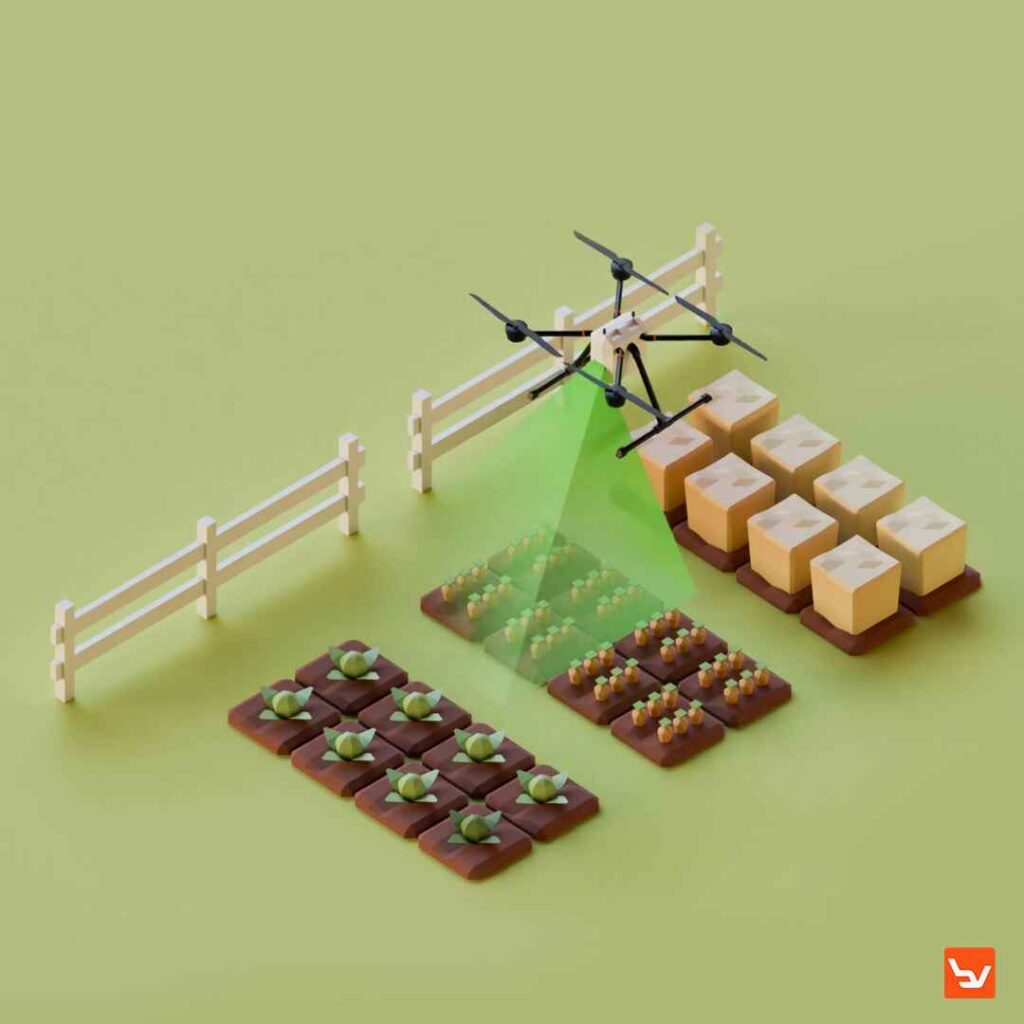
Großflächige Überwachung
Mit ihrer Fähigkeit, große Gebiete abzudecken, können Starrflügler-Drohnen mehrere Betriebe in einem Flug überwachen. Dies senkt die Betriebskosten der Landwirte durch die Bereitstellung gemeinsamer Datendienste. Mit RGB- und Infrarotkameras ausgestattete Drohnen können Fremdkörper wie Rehkitze oder Metallteile erkennen, die Erntemaschinen oder Viehbestand beschädigen könnten.
Datenerfassung durch Fernsensoren
In der Landwirtschaft können Drohnen mit Hilfe von Bodensensoren Daten über Umweltfaktoren wie Feuchtigkeit und Temperatur sammeln. Diese Integration hilft, die Einschränkungen drahtloser Sensoren mit begrenzter Batterielebensdauer zu überwinden, indem Drohnen zum Abrufen von Sensormesswerten eingesetzt werden.
In-Situ-Messungen und Manipulationen
Zu den neuartigen Anwendungen von UAS gehören Drohnen, die mit Manipulatoren ausgestattet sind, um physische Proben zu sammeln oder einfache Aufgaben in schwer zugänglichen Gebieten durchzuführen. Diese Fähigkeit könnte die Art und Weise revolutionieren, wie Landwirte den Zustand von Pflanzen beurteilen oder Bodenproben nehmen, ohne das Gelände zu beschädigen.
Analyse von Gras in niedriger Höhe
Ein mit Nahinfrarot-Sensoren (NIR) ausgestatteter UAS-Prototyp wurde entwickelt, um die Grasreife in der Milchviehhaltung zu analysieren. Durch die Messung der Verdaulichkeit von Gras in Echtzeit können Landwirte die Silageernte optimieren, was für die Gewährleistung der Futterqualität entscheidend ist.
Multispektrale Bildgebung für die Präzisionslandwirtschaft
Mit Multispektralkameras ausgestattete Drohnen können Daten über den Gesundheitszustand von Pflanzen sammeln, indem sie verschiedene Spektralbänder wie RGB, Nahinfrarot und Rotrand erfassen. Diese Bilder werden dann verarbeitet, um detaillierte Karten zu erstellen, mit denen Landwirte Nährstoffmängel, Schädlingsbefall und Wasserstress überwachen können.
Autonome Drohne - Aufladen und Mobilität
Autonomes Aufladen ist der Schlüssel zu langfristigen UAS-Einsätzen. Die Entwicklung von Ladestationen für Drohnen ermöglicht das Aufladen ohne menschliches Eingreifen. Darüber hinaus wird durch die Integration dieser Ladestationen mit autonomen Bodenfahrzeugen (AGV) die Mobilität von UAS-Einsätzen in großen Betrieben verbessert.
Systemanforderungen für unbemannte autonome Fahrzeuge (UAV) in der Landwirtschaft
Um autonome UAS in der Landwirtschaft einzusetzen, müssen mehrere kritische Systemanforderungen berücksichtigt werden:
- Autonome Basisstationen - Diese Stationen unterstützen UAS beim Aufladen der Batterien und bei der Datenübertragung und ermöglichen einen kontinuierlichen Betrieb ohne menschliches Eingreifen.
- Modularität - UAS müssen modular aufgebaut sein, damit Teile und Nutzlasten je nach Aufgabe leicht ausgetauscht werden können. Diese Flexibilität ist für die rauen Umgebungen, die typischerweise in der Landwirtschaft anzutreffen sind, entscheidend.
- Hochpräzise Navigation - Die Präzisionslandwirtschaft erfordert eine genaue Positionierung, die durch den Einsatz von Technologien wie Echtzeit-Kinematik (RTK) und Post-Processed Kinematic (PPK) GNSS erreicht werden kann.
- Anpassungsfähige Kommunikationssysteme - Der Einsatz von UAS in landwirtschaftlichen Betrieben, häufig in ländlichen Gebieten, erfordert robuste Kommunikationssysteme. Im Rahmen des Projekts wurden verschiedene Kommunikationstechnologien, darunter Wi-Fi, Bluetooth und 4G, auf ihre Eignung für verschiedene landwirtschaftliche Szenarien getestet.
Herausforderungen und Chancen
Obwohl die technologischen Fortschritte bei autonomen UAS vielversprechend sind, gibt es noch einige Herausforderungen. So besteht zum Beispiel Bedarf an einem standardisierten Rahmen, der die nahtlose Integration von UAS mit anderen landwirtschaftlichen Systemen unterstützt. Darüber hinaus müssen regulatorische Hürden, insbesondere im Zusammenhang mit vollständig autonomen Operationen, überwunden werden, um das volle Potenzial der UAS-Technologie zu erschließen.
Trotz dieser Herausforderungen sieht die Zukunft der UAS in der Landwirtschaft vielversprechend aus. Autonome UAS-Systeme können die Arbeitskosten erheblich senken, die Entscheidungsfindung verbessern und die Produktivität in landwirtschaftlichen Betrieben steigern. Die Flexibilität von UAS ermöglicht außerdem zahlreiche Anwendungsfälle, die über die einfache Ernteüberwachung hinausgehen, wie z. B. Viehhaltung, Bodenanalyse und sogar Obsternte. Darüber hinaus hat das AFarCloud-Projekt die Machbarkeit des Einsatzes von Drohnen in Verbindung mit KI-gestützter Datenanalyse demonstriert und bietet Landwirten eine umfassendere Lösung für die Verwaltung ihrer Betriebe.
Trotz dieser Herausforderungen sieht die Zukunft der UAS in der Landwirtschaft vielversprechend aus. Autonome UAS-Systeme können die Arbeitskosten erheblich senken, die Entscheidungsfindung verbessern und die Produktivität in landwirtschaftlichen Betrieben steigern. Die Flexibilität von UAS ermöglicht außerdem zahlreiche Anwendungsfälle, die über die einfache Ernteüberwachung hinausgehen, wie z. B. Viehhaltung, Bodenanalyse und sogar Obsternte. Darüber hinaus hat das AFarCloud-Projekt die Machbarkeit des Einsatzes von Drohnen in Verbindung mit KI-gestützter Datenanalyse demonstriert und bietet Landwirten eine umfassendere Lösung für die Verwaltung ihrer Betriebe.
Schlussfolgerung: Ein Weg in die Zukunft für UAV in der Landwirtschaft
Die Integration von landwirtschaftlichen Drohnen ist für die Zukunft der autonomen Landwirtschaft von entscheidender Bedeutung. Das AFarCloud-Projekt hat die Vorteile von Drohnen bei der Bereitstellung verwertbarer Erkenntnisse und der Integration mit anderen Systemen gezeigt. In dem Maße, in dem europäische Regelungen wie die U-Space-Initiative voranschreiten, wird der Einsatz von vollständig autonomen Drohnen voraussichtlich zunehmen. Wichtige Entwicklungen bei autonomen Basisstationen, modularen Designs und fortschrittlichen Kommunikationssystemen werden diesen Fortschritt vorantreiben. Mit fortlaufender Forschung und regulatorischer Unterstützung werden autonome Drohnen zu wichtigen Instrumenten für die Optimierung der Ressourcennutzung und die Steigerung der Produktivität in der Landwirtschaft.
3-Minuten-Zusammenfassung
Sie haben jetzt keine Zeit, den ganzen Artikel zu lesen? In dieser dreiminütigen Zusammenfassung finden Sie die wichtigsten Punkte des Artikels.
Autonome Drohnen verändern die Landwirtschaft durch mehr Präzision und Effizienz. Diese UAS-Technologien ermöglichen die Datenerfassung in Echtzeit, die automatische Überwachung und die nahtlose Integration in Farm-Management-Systeme. Neue EU-Verordnungen, darunter die U-Space-Initiative, unterstützen die sichere Verbreitung dieser Technologien. Trotz einiger Herausforderungen sieht die Zukunft rosig aus, denn autonome Drohnen versprechen eine höhere Produktivität und ein besseres Ressourcenmanagement in der Landwirtschaft. Das AFarCloud-Projekt zeigt die erheblichen Vorteile dieser Fortschritte in der Präzisionslandwirtschaft.
Ihre Fragen beantwortet
Eine schnelle Frage- und Antwortrunde, die sich mit den Spitzentechnologien für UAV-Tests befasst, von der Erzeugung autonomer Umgebungen bis hin zu maschinellem Lernen und satellitengestützten Simulationen.
Was ist der Hauptnutzen der Integration autonomer UAS in die Präzisionslandwirtschaft?
Der Hauptvorteil ist die verbesserte Präzision und Effizienz in der Landwirtschaft. Autonome UAS ermöglichen die Datenerfassung und -überwachung in Echtzeit, was zu einer Maximierung der Erträge bei gleichzeitiger Minimierung des Ressourcenverbrauchs (z. B. Wasser, Dünger und Arbeitskräfte) beiträgt.
Wozu können Drohnen in der Landwirtschaft eingesetzt werden?
Drohnen können für die großflächige Überwachung, die Sammlung von Sensordaten aus der Ferne, In-situ-Messungen und -Manipulationen, die Analyse von Gras in geringer Höhe, die multispektrale Bildgebung für die Präzisionslandwirtschaft sowie die autonome Aufladung und Mobilität von Drohnen eingesetzt werden.
Welche technologischen Fortschritte sind notwendig, um volle Autonomie im UAS-Betrieb zu erreichen?
Zu den notwendigen Fortschritten gehören eine längere Akkulaufzeit, eine bessere Kommunikationsinfrastruktur und die Entwicklung autonomer Ladestationen, damit Drohnen über längere Zeiträume ohne menschliches Eingreifen arbeiten können.
Welche besonderen Merkmale machen mit Multispektralkameras ausgestattete Drohnen für die Präzisionslandwirtschaft wertvoll?
Drohnen mit Multispektralkameras können verschiedene Spektralbereiche erfassen, z. B. RGB, Nahinfrarot und Rot-Rand. Dies ermöglicht eine detaillierte Analyse der Pflanzengesundheit, des Nährstoffmangels, des Schädlingsbefalls und des Wasserstresses und hilft Landwirten, fundierte Entscheidungen zu treffen.
Warum ist die Entwicklung von autonomen Basisstationen für UAS in der Landwirtschaft wichtig?
Autonome Basisstationen sind von entscheidender Bedeutung, da sie es den Drohnen ermöglichen, ihre Batterien aufzuladen und Daten ohne menschliches Zutun zu übertragen, was einen kontinuierlichen Betrieb und lange Einsätze ermöglicht.
Welche Fortschritte sind erforderlich, um die Kommunikationsinfrastruktur für autonome UAS zu verbessern?
Zu den erforderlichen Fortschritten gehört die Entwicklung robusterer und zuverlässigerer Kommunikationssysteme, die in ländlichen und abgelegenen Gebieten effektiv funktionieren. Technologien wie verbesserte Wi-Fi-, Bluetooth- und 4G/5G-Netze müssen für landwirtschaftliche Umgebungen optimiert werden.
Welchen Nutzen hat die Integration autonomer UAS in ein Farm Management System (FMS) für Landwirte?
Die Integration von UAS in ein FMS ermöglicht die automatische Datenerfassung und -analyse aus verschiedenen Quellen, einschließlich Drohnen und bodengestützten Sensoren. Dies erleichtert die automatisierte Entscheidungsfindung für Aufgaben wie Bewässerung, Düngung und Schädlingsbekämpfung und reduziert den Bedarf an technischem Fachwissen.
- Diese Publikation weitergeben
